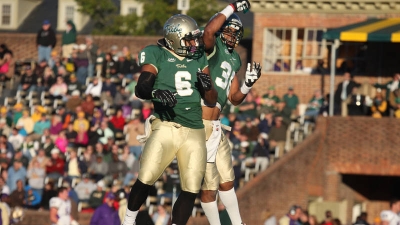By Trey Henderson
Safeties Coach
College of William and Mary
Introduction
 I would like to take this opportunity to thank Mike Kuchar, Research Manager for X&O Labs for allowing me to write this article on Press Coverage. Most of what I know about the game of football has been given to me by someone. I would like to thank them all, but there are just too many to mention.
I would like to take this opportunity to thank Mike Kuchar, Research Manager for X&O Labs for allowing me to write this article on Press Coverage. Most of what I know about the game of football has been given to me by someone. I would like to thank them all, but there are just too many to mention.
In 2010, William and Mary finished the year as the CAA Champions with the #2 Overall seed in the Division I playoffs. Defensively, we were sixth in points allowed per game (16.6 ppg) and tenth in Pass Efficiency Defense (103.6) in all of FCS. We also allowed only six passing touchdowns. The reason for our success is because of our ability to play Press Coverage no matter where we are on the field. In this article, I will explain our basic press man to man technique and how to better defend the fade stop route.
The teaching progression we us in our Press Technique, at William and Mary, can be illustrated by the acronym (AKRE) :
Alignment, Key, Responsibility and Execution. We use this acronym for every coverage we install, regardless of zone or man. So let’s get to work.
Alignment – If we are lining up on a #1 WR that is on the LOS (Line of Scrimmage) then we align one yard off the ball with inside leverage on the WR. If the WR is off the LOS then we align as tight to the LOS without being off sides while still having inside leverage. We define Inside leverage as having our outside foot splitting the WR in half. Our stance is square with our feet slightly wider than shoulder width. This give us a good base and allows us to not get run over if a WR decides to bull rush us. Also, we are in a good knee bent position with our hand relaxed ready to strike.
Key – Our eyes are locked on the bottom of the WR numbers.
Responsibility – The WR Man to Man.
Execution – We want to be as physical as possible in our three-yard area surrounding us and the WR. Our feet need to move before our hands, so that our punch is more violent. Moving your feet provides a better balance for the punch. If we dominate this area, then we should disrupt the timing of any route. As the WR moves we move our feet, I begin by telling our guys to slide back slightly(slide technique is defined below) when the WR moves to prevent them from lunging. As we slide back grudgingly from the WR, we remain as square as possible. We use an off handed punch technique on the WR. This means if the WR releases to our right then we slide our feet to stay square and maintain our leverage and punch with our left hand. Our aiming point is the breastplate of the WR with our thumb up. This gives us the most power to punch the WR and impede his release.
Get X&O Labs' Research Reports Sent Directly to Your Email Every Tuesday Morning. Just Enter Your
Principles of Slide Technique:
Safeties Coach
College of William and Mary
Introduction
 I would like to take this opportunity to thank Mike Kuchar, Research Manager for X&O Labs for allowing me to write this article on Press Coverage. Most of what I know about the game of football has been given to me by someone. I would like to thank them all, but there are just too many to mention.
I would like to take this opportunity to thank Mike Kuchar, Research Manager for X&O Labs for allowing me to write this article on Press Coverage. Most of what I know about the game of football has been given to me by someone. I would like to thank them all, but there are just too many to mention.In 2010, William and Mary finished the year as the CAA Champions with the #2 Overall seed in the Division I playoffs. Defensively, we were sixth in points allowed per game (16.6 ppg) and tenth in Pass Efficiency Defense (103.6) in all of FCS. We also allowed only six passing touchdowns. The reason for our success is because of our ability to play Press Coverage no matter where we are on the field. In this article, I will explain our basic press man to man technique and how to better defend the fade stop route.
The teaching progression we us in our Press Technique, at William and Mary, can be illustrated by the acronym (AKRE) :
Alignment, Key, Responsibility and Execution. We use this acronym for every coverage we install, regardless of zone or man. So let’s get to work.
Alignment – If we are lining up on a #1 WR that is on the LOS (Line of Scrimmage) then we align one yard off the ball with inside leverage on the WR. If the WR is off the LOS then we align as tight to the LOS without being off sides while still having inside leverage. We define Inside leverage as having our outside foot splitting the WR in half. Our stance is square with our feet slightly wider than shoulder width. This give us a good base and allows us to not get run over if a WR decides to bull rush us. Also, we are in a good knee bent position with our hand relaxed ready to strike.
Key – Our eyes are locked on the bottom of the WR numbers.
Responsibility – The WR Man to Man.
Execution – We want to be as physical as possible in our three-yard area surrounding us and the WR. Our feet need to move before our hands, so that our punch is more violent. Moving your feet provides a better balance for the punch. If we dominate this area, then we should disrupt the timing of any route. As the WR moves we move our feet, I begin by telling our guys to slide back slightly(slide technique is defined below) when the WR moves to prevent them from lunging. As we slide back grudgingly from the WR, we remain as square as possible. We use an off handed punch technique on the WR. This means if the WR releases to our right then we slide our feet to stay square and maintain our leverage and punch with our left hand. Our aiming point is the breastplate of the WR with our thumb up. This gives us the most power to punch the WR and impede his release.
Get X&O Labs' Research Reports Sent Directly to Your Email Every Tuesday Morning. Just Enter Your
Principles of Slide Technique:
- Balance stance, no stagger.
- Weight on balls of feet (similar to a boxer), no forward lean, no heels.
- Six inch to one foot slide backwards depending on ability of receiver. For most dynamic receivers, a longer slide is necessary.









